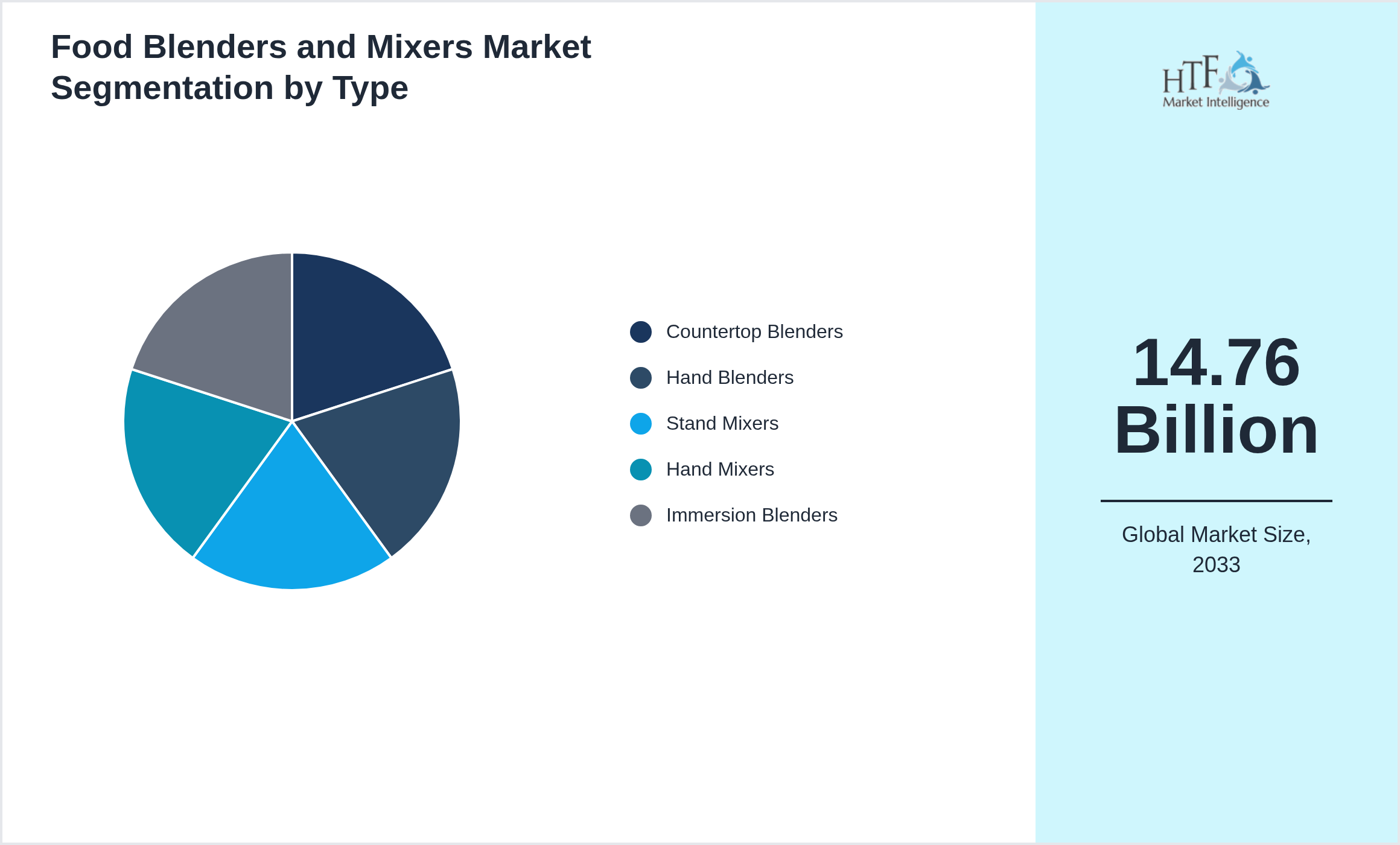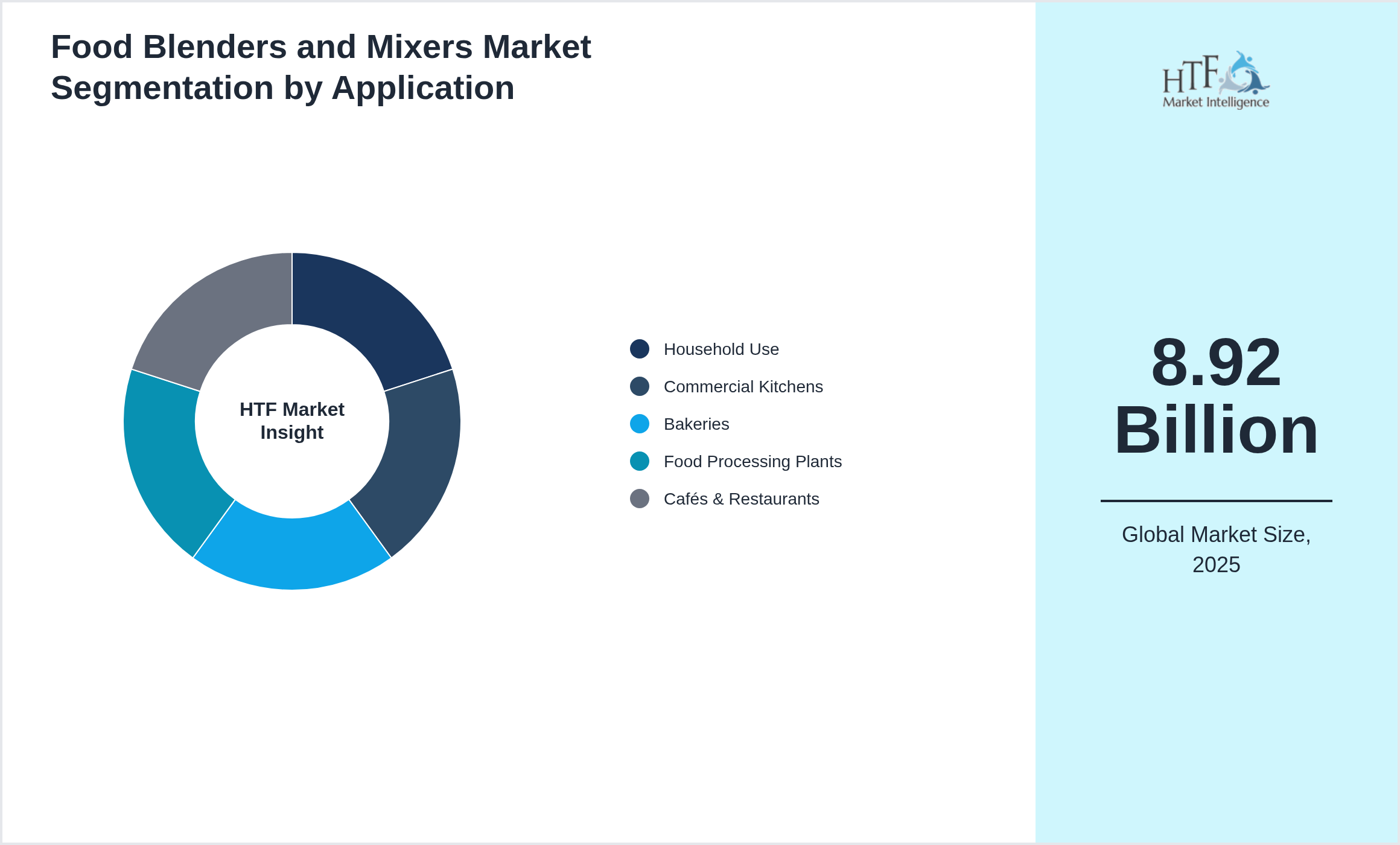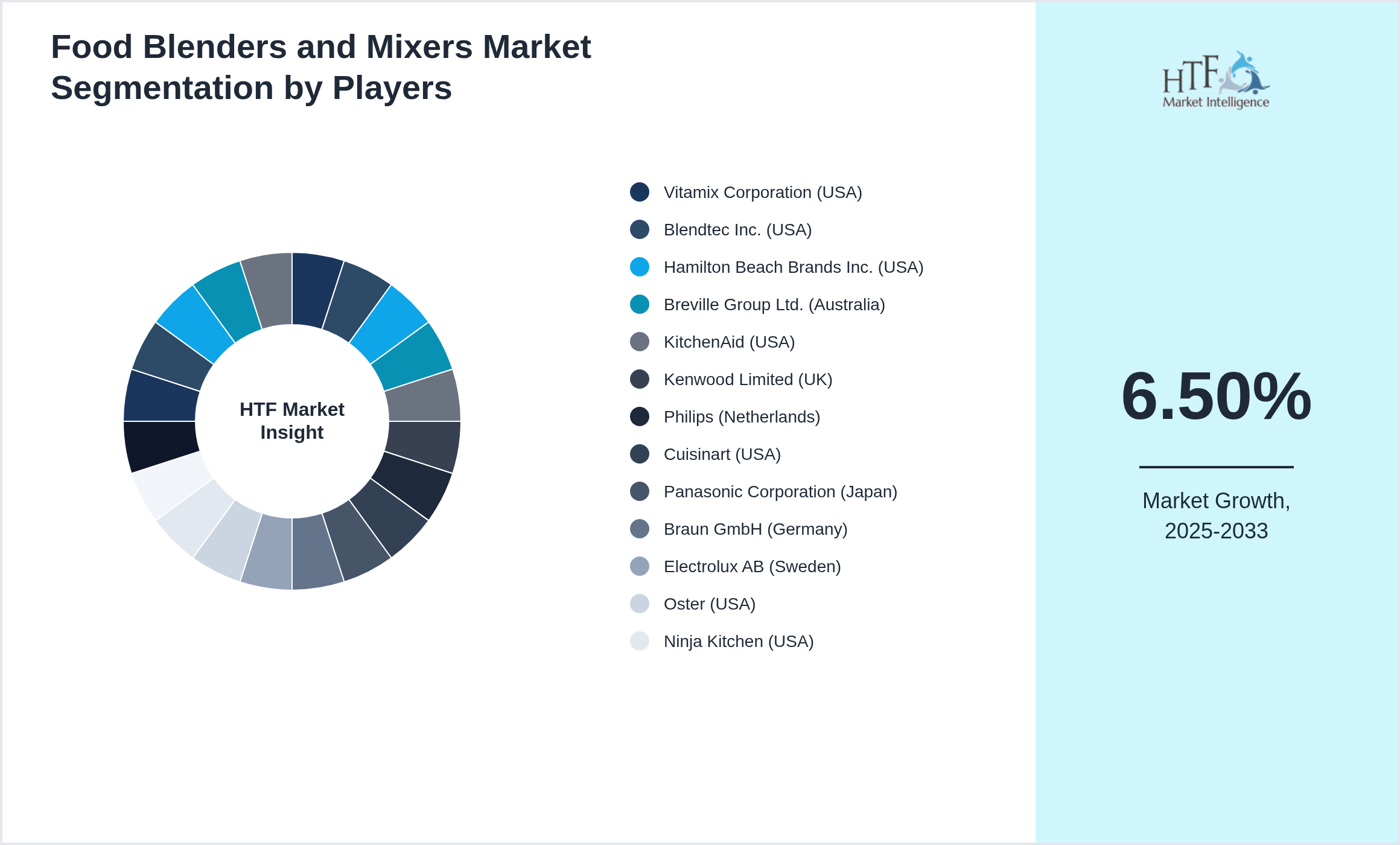Food Blenders and Mixers Market Research Report
Global Food Blenders and Mixers Market Size, Growth & Revenue 2025-2033
Global Food Blenders and Mixers Market is segmented by Application (Household Use, Commercial Kitchens, Bakeries, Food Processing Plants, Cafés & Restaurants), Type (Countertop Blenders, Hand Blenders, Stand Mixers, Hand Mixers, Immersion Blenders), and Geography (North America, LATAM, West Europe, Central & Eastern Europe, Northern Europe, Southern Europe, East Asia, Southeast Asia, South Asia, Central Asia, Oceania, MEA)
Pricing
Industry Overview
Global Food Blenders and Mixers Market Size, Forecast, Segment Analysis, By Type Countertop Blenders, Hand Blenders, Stand Mixers, Hand Mixers, Immersion Blenders By Application Household Use, Commercial Kitchens, Bakeries, Food Processing Plants, Cafés & Restaurants, By Region North America, LATAM, West Europe, Central & Eastern Europe, Northern Europe, Southern Europe, East Asia, Southeast Asia, South Asia, Central Asia, Oceania, MEA (2025 to 2033)
Food blenders and mixers are kitchen appliances designed to mix, blend, puree, or emulsify food and beverages. Used in both household and commercial kitchens, they enhance efficiency and consistency in preparing a wide variety of dishes.

The research study Food Blenders and Mixers Market provides readers with details on strategic planning and tactical business decisions that influence and stabilize growth prognosis in Food Blenders and Mixers Market. A few disruptive trends, however, will have opposing and strong influences on the development of the Global Biometric Lockers market and the distribution across players. To provide further guidance on why specific trends in Food Blenders and Mixers market would have a high impact and precisely why these trends can be factored into the market trajectory and the strategic planning of industry players.
Market Dynamics Highlighted
Market Driver
The Food Blenders and Mixers Market is experiencing significant growth due to various factors.
- • Rising demand for home cooking and baking appliances
- • Growth in commercial foodservice sector
- • Increasing trend of healthy eating and smoothie consumption
- • Product innovation in speed and efficiency
- • Expansion of online retail for kitchen appliances.
Market Trend
The Food Blenders and Mixers market is growing rapidly due to various factors.
- • Development of smart and app-connected appliances
- • Integration of energy-efficient motor technology
- • Rising popularity of compact and multifunctional designs
- • Growth in premium and aesthetically appealing products
- • Expansion of blender-mixer combos for diverse uses.
Opportunity
The Food Blenders and Mixers has several opportunities, particularly in developing countries where industrialization is growing.
Challenge
The market for fluid power systems faces several obstacles despite its promising growth possibilities.
Food Blenders and MixersMarket Segment Highlighted
Segmentation by Type
- • Countertop Blenders
- • Hand Blenders
- • Stand Mixers
- • Hand Mixers
- • Immersion Blenders

Segmentation by Application
- • Household Use
- • Commercial Kitchens
- • Bakeries
- • Food Processing Plants
- • Cafés & Restaurants

Key Players
Several key players in the Food Blenders and Mixers market is strategically focusing on expanding their operations in developing regions to capture a larger market share, particularly as the year-on-year growth rate for the market stands at N/A. The companies featured in this profile were selected based on insights from primary experts, evaluating their market penetration, product offerings, and geographical reach. By targeting emerging markets, these companies aim to leverage new opportunities, enhance their competitive advantage, and drive revenue growth. This approach not only aligns with their overall business objectives but also positions them to respond effectively to the evolving demands of consumers in these regions.
- • Vitamix Corporation (USA)
- • Blendtec Inc. (USA)
- • Hamilton Beach Brands Inc. (USA)
- • Breville Group Ltd. (Australia)
- • KitchenAid (USA)
- • Kenwood Limited (UK)
- • Philips (Netherlands)
- • Cuisinart (USA)
- • Panasonic Corporation (Japan)
- • Braun GmbH (Germany)
- • Electrolux AB (Sweden)
- • Oster (USA)
- • Ninja Kitchen (USA)
- • Morphy Richards (UK)
- • SMEG S.p.A. (Italy)
- • Sunbeam Products Inc. (USA)
- • Krups (Germany)
- • Waring (USA)
- • SharkNinja Operating LLC (USA)
- • Black+Decker Inc. (USA)

For the complete companies list, please ask for sample pages.
Market Entropy
Merger & Acquisition
Patent Analysis
Investment and Funding Scenario
Market Estimation Process
Key Highlights
• The Food Blenders and Mixers is growing at a CAGR of 6.50% during the forecasted period of 2025 to 2033
• Year on Year growth for the market is N/A
• North America dominated the market share of 8.92 Billion in 2025
• Based on type, the market is bifurcated into Countertop Blenders, Hand Blenders, Stand Mixers, Hand Mixers, Immersion Blenders segment, which dominated the market share during the forecasted period
• Based on application, the market is segmented into Application Household Use, Commercial Kitchens, Bakeries, Food Processing Plants, Cafés & Restaurants is the fastest-growing segment
• Global Import Export in terms of K Tons, K Units, and Metric Tons will be provided if Applicable based on industry best practice
Our Data Collection Process Based on Best Practice
Problem Definition: Clarify research objectives and client needs & identify key questions and market scope.
Data Collection:
Primary Research: Conduct interviews, surveys, and focus groups.
Secondary Research: Analyzed industry reports, market publications, and financial records.
Data Analysis:
Quantitative Analysis: Use statistical tools to identify trends and quantify market size.
Qualitative Analysis: Interpret non-numerical data to understand market drivers and consumer behavior.
Market Segmentation:
Divide the market into distinct segments based on shared characteristics.
Validation and Triangulation:
Cross-verify findings from multiple sources to ensure accuracy and reliability.
Reporting and Recommendations:
Present insights and strategic recommendations in a tailored, actionable report.
Continuous Feedback Loop:
Engage with clients to refine research and ensure alignment with their goals.
Regional Insight
The Food Blenders and Mixers varies widely by region, reflecting diverse economic conditions and consumer preferences. In North America, the focus is on convenience and premium products, driven by high disposable incomes and a strong e-commerce sector. Europe’s market is fragmented, with Western countries emphasizing luxury and organic goods, while Eastern Europe sees rapid growth. Asia-Pacific is a fast-growing region with high demand for high-tech and affordable products, driven by urbanization and rising middle-class incomes. Latin America prioritizes affordability amidst economic fluctuations, with Brazil and Mexico leading in market growth. In the Middle East and Africa, market trends are influenced by cultural preferences, with luxury goods prominent in the Gulf States and gradual growth in sub-Saharan Africa. Global trends like sustainability and digital transformation are impacting all regions.
The North America dominant region currently dominates the market share, fueled by increasing consumption, population growth, and sustained economic progress which collectively enhance market demand. Conversely, the Asia-Pacific is growing rapidly, driven by significant infrastructure investments, industrial expansion, and rising consumer demand.
- North America
- LATAM
- West Europe
- Central & Eastern Europe
- Northern Europe
- Southern Europe
- East Asia
- Southeast Asia
- South Asia
- Central Asia
- Oceania
- MEA
The Top-Down and Bottom-Up Approaches
The top-down approach begins with a broad theory or hypothesis and breaks it down into specific components for testing. This structured, deductive process involves developing a theory, creating hypotheses, collecting and analyzing data, and drawing conclusions. It is particularly useful when there is substantial theoretical knowledge, but it can be rigid and may overlook new phenomena.
Conversely, the bottom-up approach starts with specific data or observations, from which broader generalizations and theories are developed. This inductive process involves collecting detailed data, analyzing it for patterns, developing hypotheses, formulating theories, and validating them with additional data. While this approach is flexible and encourages the discovery of new phenomena, it can be time-consuming and less structured.
Regulatory Framework
The healthcare sector is overseen by various regulatory bodies that ensure the safety, quality, and efficacy of health services and products. In the United States, the U.S. Department of Health and Human Services (HHS) plays a crucial role in protecting public health and providing essential human services. Within HHS, the Food and Drug Administration (FDA) regulates food, drugs, and medical devices, ensuring they meet safety and efficacy standards. The Centers for Disease Control and Prevention (CDC) focus on disease control and prevention, conducting research, and providing health information to protect public health.
In the United Kingdom, the General Medical Council (GMC) regulates doctors, ensuring they adhere to professional standards. Other important bodies include the General Pharmaceutical Council (GPhC), which oversees pharmacists, and the Nursing and Midwifery Council (NMC), which regulates nurses and midwives. These organizations work to maintain high standards of care and protect patients.
Internationally, the European Medicines Agency (EMA) regulates medicines within the European Union, while the World Health Organization (WHO) provides global leadership on public health issues. Each of these regulatory bodies plays a vital role in ensuring that health care systems operate effectively and safely, ultimately safeguarding public health across different regions.
Report Infographics
| Report Features | Details |
| Base Year | 2025 |
| Based Year Market Size (2025) | 8.92 Billion |
| Historical Period | 2020 to 2025 |
| CAGR (2025 to 2033) | 6.50% |
| Forecast Period | 2025 to 2033 |
| Forecasted Period Market Size ( 2033) | 14.76 Billion |
| Scope of the Report | Countertop Blenders, Hand Blenders, Stand Mixers, Hand Mixers, Immersion Blenders, Household Use, Commercial Kitchens, Bakeries, Food Processing Plants, Cafés & Restaurants |
| Regions Covered | North America, LATAM, West Europe, Central & Eastern Europe, Northern Europe, Southern Europe, East Asia, Southeast Asia, South Asia, Central Asia, Oceania, MEA |
| Companies Covered | Vitamix Corporation (USA), Blendtec Inc. (USA), Hamilton Beach Brands Inc. (USA), Breville Group Ltd. (Australia), KitchenAid (USA), Kenwood Limited (UK), Philips (Netherlands), Cuisinart (USA), Panasonic Corporation (Japan), Braun GmbH (Germany), Electrolux AB (Sweden), Oster (USA), Ninja Kitchen (USA), Morphy Richards (UK), SMEG S.p.A. (Italy), Sunbeam Products Inc. (USA), Krups (Germany), Waring (USA), SharkNinja Operating LLC (USA), Black+Decker Inc. (USA) |
| Customization Scope | 15% Free Customization |
| Delivery Format | PDF and Excel through Email |
Food Blenders and Mixers - Table of Contents
Chapter 1: Market Preface
Chapter 2: Strategic Overview
Chapter 3: Global Food Blenders and Mixers Market Business Environment & Changing Dynamics
Chapter 4: Global Food Blenders and Mixers Industry Factors Assessment
Chapter 5: Food Blenders and Mixers : Competition Benchmarking & Performance Evaluation
Chapter 6: Global Food Blenders and Mixers Market: Company Profiles
Chapter 7: Global Food Blenders and Mixers by Type & Application (2020-2033)
Chapter 8: North America Food Blenders and Mixers Market Breakdown by Country, Type & Application
Chapter 9: Europe Food Blenders and Mixers Market Breakdown by Country, Type & Application
Chapter 10: Asia Pacific Food Blenders and Mixers Market Breakdown by Country, Type & Application
Chapter 11: Latin America Food Blenders and Mixers Market Breakdown by Country, Type & Application
Chapter 12: Middle East & Africa Food Blenders and Mixers Market Breakdown by Country, Type & Application
Chapter 13: Research Finding and Conclusion
Frequently Asked Questions (FAQ):
The Compact Track Loaders market is projected to grow at a CAGR of 6.8% from 2025 to 2030, driven by increasing demand in construction and agricultural sectors.
North America currently leads the market with approximately 45% market share, followed by Europe at 28% and Asia-Pacific at 22%. The remaining regions account for 5% of the global market.
Key growth drivers include increasing construction activities, rising demand for versatile equipment in agriculture, technological advancements in track loader design, and growing preference for compact equipment in urban construction projects.
